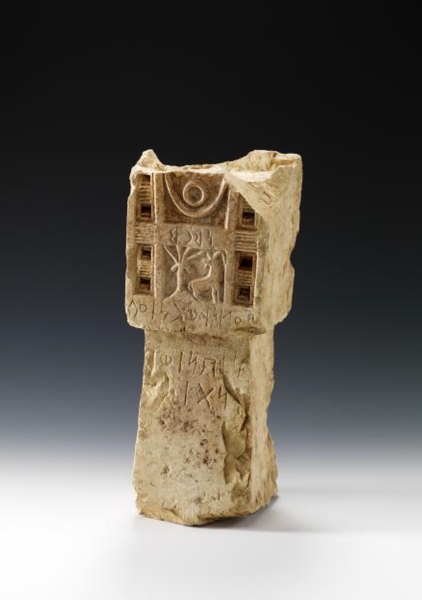

A Pre-BCE Limestone Censer is a censer made of limestone, discovered in the archaeological Qaryat al-Faw, located southeast of Wadi ad-Dawasir Governorate, Riyadh Province, the Kingdom of Saudi Arabia. It dates back to the period between the third century BCE and the third century CE and was used for burning incense.
Specifications of the limestone censer
The pre-BCE limestone censer has a height of forty-two cm. Its upper section measures sixteen × sixteen × nineteen cm, while the lower section measures sixteen × sixteen × twenty-three cm. The censer features a raised square base that slightly widens at the bottom. Resting on this base is a tall basin, which is wider than the base. The upper edges of the basin are partially broken in some areas. One of the censer's faces is divided into two sections by a raised carved strip, with both ends forming prominent carved edges. The upper section contains a recessed central area, featuring a raised crescent carving at its center. Inside the crescent is a hollow circle with a raised border. To the right of the crescent, there is a vertically carved raised column, followed by a wide band, bordered by a raised carving. Within this band, there are two recessed squares, separated by horizontally carved raised strips arranged vertically. To the left of the crescent, another vertically carved raised column appears, followed by a wide band, also bordered by a raised carving. Within this band, there are two recessed squares, separated by horizontally carved raised strips arranged vertically.
The lower section features a central recessed carving. On the left side, there is a raised carving of a palm tree, with its roots extending into the lower edge of the basin, while its upright fronds touch the upper section of the basin’s front face. To the left of the palm tree, a raised carving of a mountain goat is depicted in a tense stance, with its head turned backward and long, curved horns. To the right of the crescent, a vertically carved raised column is present, followed by a wide band bordered by a raised carving. Within this band, two recessed squares are adorned with horizontally carved raised strips, arranged vertically. To the left of the crescent, another vertically carved raised column appears, followed by a wide band bordered by a raised carving, with two recessed squares in its center, decorated with horizontally carved raised strips, arranged vertically. The lower part of the base shows some signs of wear. One of its faces contains an inscription in the Southern Musnad script, which reads as follows:
- NMRM.
- Ba‘al Adorn ‘Afn Bin
- Wayhanah
Significance of the limestone censer
All the decorative elements and symbols featured on the pre-BCE limestone censer emphasize its significance and its connection to architectural representations. The ornamentation includes false windows, as well as carvings of the Tree of Life and an ibex, which symbolized hunting among the inhabitants of southern Arabia before Islam. The censer is preserved at the Museum of the Department of Archaeology at King Saud University in Riyadh and is cataloged under the number 24 F 10.
Related quizzes
Related articles
